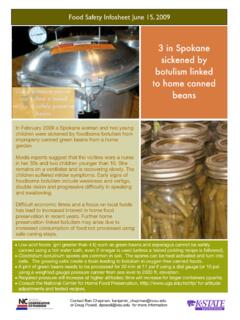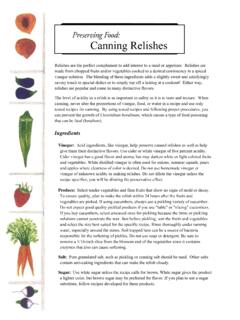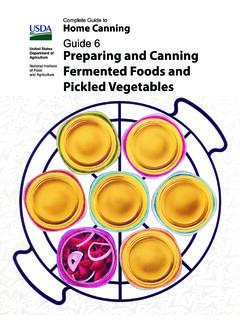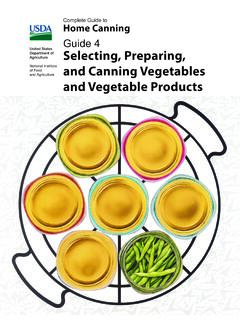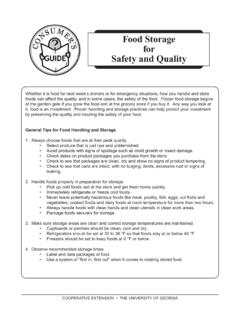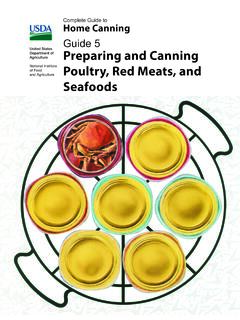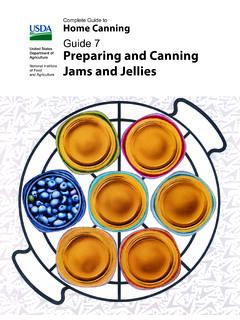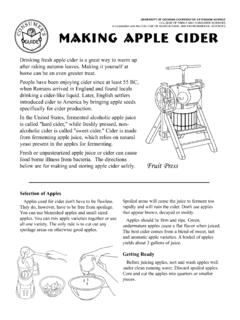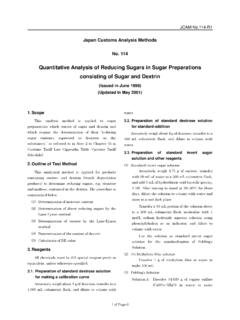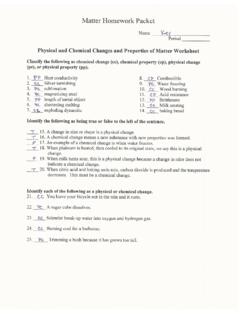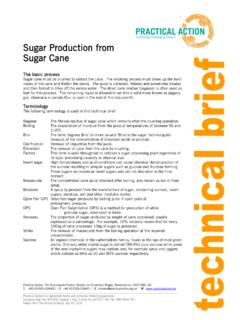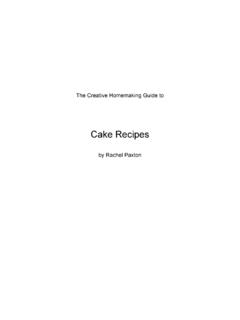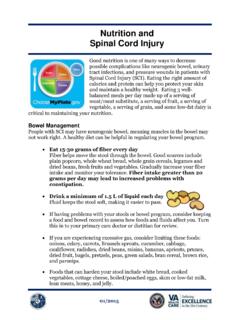Transcription of Guide 3 Selecting, Preparing, and Canning Tomatoes and ...
1 Complete Guide toHome CanningGuide 3 Selecting, Preparing, and Canning Tomatoes and Tomato Products 3-2 Tomatoes and Tomato Products3 3-3 Guide 3 Selecting, Preparing, and Canning Tomatoes and Tomato ProductsTable of ContentsSection ..PageGeneral ..3-5 Tomato juice ..3-5 Tomato and vegetable juice blend ..3-6 Tomatoes crushed ..3-7 Standard tomato sauce ..3-8 Tomatoes whole or halved (packed in water) ..3-9 Tomatoes whole or halved (packed in tomato juice) ..3-10 Tomatoes whole or halved (packed raw without added liquid) ..3-11 Tomatoes with okra or zucchini ..3-12 Tomatillos ..3-13 Spaghetti sauce without meat ..3-13 Spaghetti sauce with meat ..3-14 Mexican tomato sauce ..3-15 Easy hot sauce ..3-16 Cayenne pepper sauce.
2 3-17 Tomato ketchup ..3-17 Country western ketchup ..3-18 Blender ketchup ..3-18 Salsa Recipes ..3-19 Selection and preparation of ingredients ..3-19 Chile salsa (hot tomato-pepper sauce) ..3-21 Chile salsa II ..3-22 Tomatillo green salsa ..3-22 Tomato salsa using paste Tomatoes ..3-23 Tomato salsa using slicing Tomatoes ..3-24 Tomato/green chile salsa ..3-24 Tomato/tomato paste salsa ..3-25 Tomato taco sauce ..3-26 3-4 Tomatoes and Tomato Products3 3-5 GeneralQuality: Select only disease-free, preferably vine-ripened, firm fruit for Canning . Caution: Do not can Tomatoes from dead or frost-killed vines. Green Tomatoes are more acidic than ripened fruit and can be canned safely with any of the following recommendations.
3 Acidification: To ensure safe acidity in whole, crushed, or juiced Tomatoes , add 2 tablespoons of bottled lemon juice or 1/2 teaspoon of citric acid per quart of Tomatoes . For pints, use 1 table-spoon bottled lemon juice or 1/4 teaspoon citric acid. Acid can be added directly to the jars before filling with product. Add sugar to offset acid taste, if desired. Four tablespoons of a 5 percent acidity vinegar per quart may be used instead of lemon juice or citric acid. However, vinegar may cause undesirable flavor a procedure in this Guide for Canning Tomatoes offers both boiling water and pressure Canning options, all steps in the preparation ( Procedure ) are still required even if the pressure processing option is chosen.
4 This includes acidification. The boiling water and pressure alterna-tives are equal processes with different time/temperature combinations calculated for these products. Recommendation: Use of a pressure canner will result in higher quality and more nutritious canned tomato products. If your pressure canner cannot be operated above 15 PSI, select a process time at a lower JUICEQ uantity: An average of 23 pounds is needed per canner load of 7 quarts, or an average of 14 pounds per canner load of 9 pints. A bushel weighs 53 pounds and yields 15 to 18 quarts of juice an average of 3-1/4 pounds per : Wash, remove stems, and trim off bruised or discolored portions. To prevent juice from separating, quickly cut about 1 pound of fruit into quarters and put directly into saucepan.
5 Heat immediately to boiling while crushing. Continue to slowly add and crush freshly cut tomato quarters to the boiling mixture. Make sure the mixture boils constantly and vigorously while you add the remaining Tomatoes . Simmer 5 minutes after you add all pieces. If you are not concerned about juice separation, simply slice or quarter Tomatoes into a large saucepan. Crush, heat, and simmer for 5 minutes before both types of heated juice through a sieve or food mill to remove skins and seeds. Add bottled lemon juice or citric acid to jars. See acidification instructions on page 3-5. Heat juice again to boiling . Add 1 teaspoon of salt per quart to the jars, if desired. Fill hot jars with hot toma-to juice, leaving 1/2-inch headspace.
6 Wipe rims of jars with a dampened clean paper towel. Adjust lids and process. (Acidification is still required for the pressure Canning options; follow all steps in the Procedures above for any of the processing options.) 3-6 TOMATO AND VEGETABLE JUICE BLENDQ uantity: An average of 22 pounds of Tomatoes is needed per canner load of 7 quarts. No more than 3 cups of other vegetables may be added for each 22 pounds of : Crush and simmer Tomatoes as for making tomato juice (see page 3-5). Add no more than 3 cups of any combination of finely chopped celery, onions, carrots, and peppers for each 22 lbs of Tomatoes . Simmer mixture 20 minutes. Press hot cooked Tomatoes and vegetables through a sieve or food mill to remove skins and seeds.
7 Add bottled lemon juice or citric acid to jars. See acidification directions on page 3-5. Add 1 teaspoon of salt per quart to the jars, if desired. Reheat tomato-vegetable juice blend to boiling and fill immediately into hot jars, leaving 1/2-inch head-space. Wipe rims of jars with a dampened clean paper towel. Adjust lids and process. (Acidifica-tion is still required for the pressure Canning options; follow all steps in the Procedures above for any of the processing options.) Canning Guide 3 TablesTomato JuiceRecommended process time for Tomato Juice in a boiling -water cannerProcess Time at Altitudes ofStyleof PackJarSize0 1,000 ft1,001 3,000 ft3,001 6,000 ftAbove6,000 ftHotPints35 min 404550 Quarts40455055 Recommended process time for Tomato Juice in adial-gauge pressure cannerCanner Pressure (PSI) at Altitudes ofStyleof PackJarSizeProcessTime0 2,000 ft2,001 4,000 ft4,001 6,000 ft6,001 8,000 ft20 min6 lb7 lb8 lb9 lbHot1511121314 PintsorQuartsRecommended process time for Tomato Juice in aweighted-gauge pressure cannerCanner Pressure (PSI)
8 At Altitudes ofStyleof PackJarSizeProcessTime0 1,000 ftAbove1,000 ft20 min5 lb10 lbHot151015 PintsorQuarts1015 Not recommendedTomatoes and Tomato Products3 3-7 Tomatoes -CRUSHED (with no added liquid)A high-quality product, ideally suited for use in soups, stews, and casseroles. This recipe is similar to that formerly referred to as Quartered Tomatoes . Quantity: An average of 22 pounds is needed per canner load of 7 quarts; an average of 14 fresh pounds is needed per canner load of 9 pints. A bushel weighs 53 pounds and yields 17 to 20 quarts of crushed Tomatoes an average of 2-3/4 pounds per : Wash Tomatoes and dip in boiling water for 30 to 60 seconds or until skins split. Then dip in cold water, slip off skins, and remove cores.
9 Trim off any bruised or discolored portions and quarter. Heat one-sixth of the quarters quickly in a large pot, crushing them with a wooden mallet or spoon as they are added to the pot. This will exude juice. Continue heating the Tomatoes , stirring to prevent burning. Once the Tomatoes are boiling , gradually add remaining quartered Tomatoes , stirring constantly. These remaining Tomatoes do not need to be crushed. They will soften with heating and stirring. Continue until all Tomatoes are added. Then boil gently 5 minutes. Add bottled lemon juice or citric acid to jars. See acidification directions on page 3-5. Add 1 teaspoon of salt per quart to the jars, if desired. Fill hot jars immediately with hot Tomatoes , leaving 1/2-inch headspace.
10 Remove air bubbles and adjust headspace if needed. Wipe rims of jars with a damp-ened clean paper towel. Adjust lids and process. (Acidification is still required for the pressure Canning options; follow all steps in the Procedures above for any of the processing options.)Tomato-Vegetable BlendRecommended process time for Tomato-Vegetable Blend in a boiling -water cannerProcess Time at Altitudes ofStyleof PackJarSize0 1,000 ft1,001 3,000 ft3,001 6,000 ftAbove6,000 ftHotPints35 min 404550 Quarts40455055 Recommended process time for Tomato-Vegetable Blend in adial-gauge pressure cannerCanner Pressure (PSI) at Altitudes ofStyleof PackJarSizeProcessTime0 2,000 ft2,001 4,000 ft4,001 6,000 ft6,001 8,000 ft20 min6 lb7 lb8 lb9 lbHot1511121314 PintsorQuartsRecommended process time for Tomato-Vegetable Blend in aweighted-gauge pressure cannerCanner Pressure (PSI)
